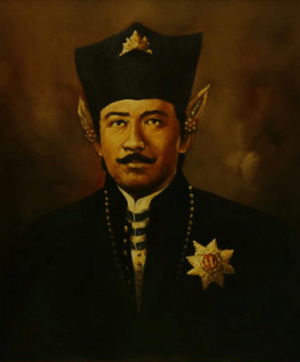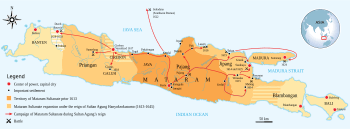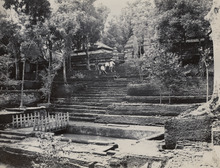Sultan Agung of Mataram facts for kids
Quick facts for kids Anyakrakusuma |
|||||||||
|---|---|---|---|---|---|---|---|---|---|
| Sultan Agung Sultan Abdullah Muhammad Maulana Matarani al-Jawi |
|||||||||

Portrait of Sultan Agung
|
|||||||||
| 3th Sultan of Mataram | |||||||||
| reign | 1613–1645 | ||||||||
| Preceded by | Duke Martapura | ||||||||
| Succeeded by | Amangkurat I | ||||||||
| Born | Raden Mas Jatmika 1593 Kutagede, Mataram |
||||||||
| Died | 1645 (aged 51–52) Karta, Mataram |
||||||||
| Burial | Astana Kasultan Agungan | ||||||||
| Queen consort | Ratu Kulon (first) Ratu Wetan (second) |
||||||||
|
|||||||||
| Dynasty | Mataram | ||||||||
| Father | Anyakrawati | ||||||||
| Mother | Dyah Banawati | ||||||||
| Religion | Islam | ||||||||
| National Hero of Indonesia S.K. President No. 106 / TK / 1975 dated November 3, 1975. |
|||||||||
Sultan Anyakrakusuma, better known as Sultan Agung, was a powerful ruler of the Mataram Sultanate in Central Java. He ruled from 1613 to 1645. Sultan Agung was a skilled military leader who expanded his kingdom. He made Mataram the strongest power in the region during his time.
People often call him Sultan Agung or Susuhunan Agung, which means "Great Sultan" or "Majestic Sultan." Many stories and books have been written about him. He is remembered as a strong Javanese leader and a fighter against the Dutch East India Company. This company was a powerful trading group from the Netherlands.
Sultan Agung is seen as a hero who mixed history with myths and magic. The Dutch even called him Agoeng de Grote, meaning "Agung the Great." Because of his important role as a leader and cultural figure, Sultan Agung was named a National Hero of Indonesia on November 3, 1975.
Contents
Biography
How Sultan Agung Became Ruler
Rangsang, who would become Sultan Agung, became ruler when he was 20 years old. He took over from his half-brother, Duke Martapura. Duke Martapura was only sultan for one day. Rangsang was technically the fourth sultan. However, people usually count him as the third. This is because his half-brother had a mental disability. His father had made a promise to his mother, Queen Tulungayu, to make him sultan.
In Sultan Agung's second year as ruler, his chief minister, Patih Mandaraka, passed away. Tumenggung Singaranu took over his important job.
When Sultan Agung first became ruler, Mataram's capital city was Kotagede. In 1614, a new palace was built in Karta, about 5 kilometers southwest of Kotagede. The royal family moved into this new Karta Palace four years later.
Expanding the Mataram Kingdom
Sultan Agung became the ruler of Mataram in 1613. The next year, he tried to conquer Surabaya and Malang in eastern Java. He did not succeed at first. However, he did get a lot of money from them. In 1615, he used this money to conquer Wirasaba (now Mojoagung). He led this military operation himself.
In 1616, Surabaya tried to attack Mataram back. But Surabaya did not have enough allies. Sultan Agung's army defeated them in Siwalan, Pajang. Later that year, he conquered the coastal city of Lasem. In 1617, Pasuruan was taken. In 1619, Tuban, a very old and big city on the coast, also fell to Mataram.
Surabaya was Mataram's toughest enemy. Sultan Agung's grandfather and father had tried and failed to conquer it. Sultan Agung weakened Surabaya by capturing its ally, Sukadana, in southwest Kalimantan in 1622. He also captured the island of Madura, another ally of Surabaya, in 1624 after a big battle. After five years of fighting, Sultan Agung finally conquered Surabaya in 1625.
With Surabaya under his control, Mataram ruled almost all of central and eastern Java, including Madura. Only the western part of Java, like Banten and the Dutch settlement in Batavia, remained free from his rule.
Mataram's economy was mostly based on farming. Sultan Agung did not care much for sea trade. So, he did not have a strong navy. This became a problem later. In 1629, he tried to attack the Dutch base in Jakarta. Even though his land army was bigger, the Dutch had a much stronger navy. They were able to defend their city during the Siege of Batavia.
After failing to capture Batavia, Sultan Agung turned his attention to the Balinese. They controlled Balambangan in East Java. He fought a "holy war" against them. He succeeded in Java, but he could not conquer the island of Bali itself. This is why Bali remained a Hindu state.
Challenges and Rebellions
By 1625, Mataram was the main power in Java. But some areas that were under Mataram's rule still rebelled. This happened because Sultan Agung could not conquer Batavia. Pajang rebelled in 1617, and Pati rebelled in 1627. After Surabaya was captured in 1625, Mataram's expansion slowed down due to these rebellions.
In 1630, Mataram stopped a rebellion in Tembayat. From 1631 to 1636, Mataram also had to put down rebellions in Sumedang and Ukur in West Java. Sultan Agung's attempts to take Batavia in 1628–1629 failed.
Another rebellion was the Giri Kedaton rebellion. The people there did not want to be ruled by Mataram. Mataram's soldiers respected Giri Kedaton's fighters. This was because they were descendants of Sunan Giri, a famous religious leader. So, Sultan Agung asked Pangeran Pekik to stop the rebellion. Pangeran Pekik was a descendant of Sunan Ampel, Sunan Giri's father-in-law. Pangeran Pekik had married Sultan Agung's sister, Queen Pandansari, in 1633. They finally stopped the Giri Kedaton rebellion three years later.
Sultan Agung's Final Years
In 1632, Sultan Agung started building Imogiri. This was meant to be his burial place. It is about 15 kilometers south of Yogyakarta. To this day, Imogiri is where most of the royal families of Yogyakarta and Surakarta are buried. Sultan Agung, Queen Batang, and their sons are also buried there.
Sultan Agung passed away in 1645. He left behind a large empire that covered most of Java and some nearby islands. As he wished, his son, RM. Sayidin, who became Amangkurat I, took over as the next ruler.
Administration and Government
One of Sultan Agung's most important achievements was how he changed the way his conquered lands were governed. As his kingdom grew, he created a new and smart system to manage it.
Besides his conquests, Sultan Agung also worked to make his kingdom's government better. He updated the tax rules. He also made the courts and legal system follow Islamic laws more closely. He ordered the building of the Karta Palace in 1614. He also built the Royal Graveyard of Imogiri and other important public buildings.
He created "provinces" by appointing special leaders called adipati (like a Duke). These leaders managed areas called kadipaten (like a Duchy). This was especially important in western Java. Here, Mataram faced the strong areas of Banten and Batavia, which resisted his rule. For example, a kabupaten like Karawang was created in 1636. Sultan Agung appointed Prince Kertabumi as its first adipati.
How Administration Changed Over Time
When the Dutch East India Company (VOC) took control of Mataram's lands, they kept the kadipaten system. Under Dutch rule, the adipati were called bupati, and the kadipaten became kabupaten. The Dutch also called these regenten and regentschappen. The title of a bupati often included "Raden Aria Adipati" before their formal name, like "Raden Aria Adipati Sastradiningrat."
The Dutch grouped these kabupaten into larger areas called residenties, each led by a resident. After Indonesia became independent, the government kept the kabupaten. However, they removed the residenties in the 1950s. This meant kabupaten became direct subdivisions of a province. Laws passed in 1999 gave a lot of power to the kabupaten, not just the provinces.
Culture and Arts
Sultan Agung also made changes to the culture of Mataram Palace. He created a special language called Bagongan. All Mataram noblemen and officials had to use it. This was to make everyone feel more equal. The language helped create unity among the royal court officials. Even the Sundanese language in West Java changed under Mataram's rule. A refined version of the language, similar to Central Java's, was developed.
Sultan Agung is also known for creating the unique Javanese calendar. This calendar is still used today. He also wrote a mystical book called Sastra Gending.
Some people believe that the sacred bedhaya dance, and important developments in gamelan music and wayang puppet shows, came from Sultan Agung's court. However, there is not much historical proof for these claims. There is little information about the arts during his rule. Some details come from Dutch writings, but they can be hard to understand.
Legacy and Importance
Sultan Agung is highly respected in Java today. He is admired for uniting Java and for his modernizing changes. He is also remembered for his wars against the Dutch. In 1975, he was officially named a National Hero of Indonesia. Because there are not many clear records of his early life, and because myths and magic are part of Javanese culture, he has become a heroic figure.
In Java's religious culture, which mixes Hinduism, Buddhism, and Islam, visiting his burial place is considered very special. Many people make a great effort to go to Imogiri on certain days in the Javanese calendar and Islamic calendar.
His influence is still strong today. For example, a 2018 Indonesian film called Sultan Agung Mataram 1628 was made about him.
Family
Sultan Agung's birth name was Raden Mas Jatmika. He was also known as Raden Mas Rangsang. His father was Anyakrawati, the second ruler of Mataram. His mother was Ratu Mas Adi Dyah Banawati, who was the daughter of Prince Benawa, the last Sultan of Pajang.
There is another story that says Sultan Agung was the son of Prince Purbaya (Anyakrawati's brother). This story claims that Prince Purbaya swapped his newborn baby with the one born to Dyah Banawati. This is a less common idea and needs more proof.
Like other Mataram rulers, Sultan Agung had two main queens:
- Ratu Kulon, born as Ratu Mas Tinumpak. She was the daughter of Panembahan Ratu, the Sultan of Cirebon. She gave birth to RM. Syahwawrat, also known as Prince Alit.
- Ratu Wetan. She was the daughter of the Duke of Batang and the granddaughter of Ki Juru Martani. She gave birth to RM. Sayidin, who later became Amangkurat I.
Sultan Agung had 9 children from his queens:
- Raden Mas Sahwawrat, also known as Pangeran Temenggong Pajang
- Raden Mas Kasim, also known as Pangeran Demang Tanpa Nangkil
- Pangeran Ronggo Kajiwan
- Gusti Ratu Ayu Winongan
- Pangeran Ngabehi Loring Pasar
- Pangeran Ngabehi Loring Pasar (This is a repeated name, likely a different child with the same title)
- Raden Mas Sayidin (who became Sunan Prabu Amangkurat Agung/Amangkurat I, Sultan Agung's successor, ruling from 1645 to 1677)
- Gusti Ratu Ayu Wiromantri
- Prince Danupoyo, also known as Raden Mas Alit
Titles and Names
When he first became ruler, Rangsang was called Susuhunan Anyakrakusuma or Prabu Pandita Anyakrakusuma. After he conquered Madura in 1624, he changed his title to Susuhunan Agung Anyakrakusuma, often shortened to Sunan Agung Anyakrakusuma.
In the 1640s, he used the title Sultan Agung Senapati ing Alaga Abdurrahman. In 1641, he received an Arabic title, Sultan Abdullah Muhammad Maulana of Mataram, from religious leaders in Mecca.
For simplicity, this article uses the most common and well-known name: Sultan Agung.
See also
 In Spanish: Agung de Mataram para niños
In Spanish: Agung de Mataram para niños



